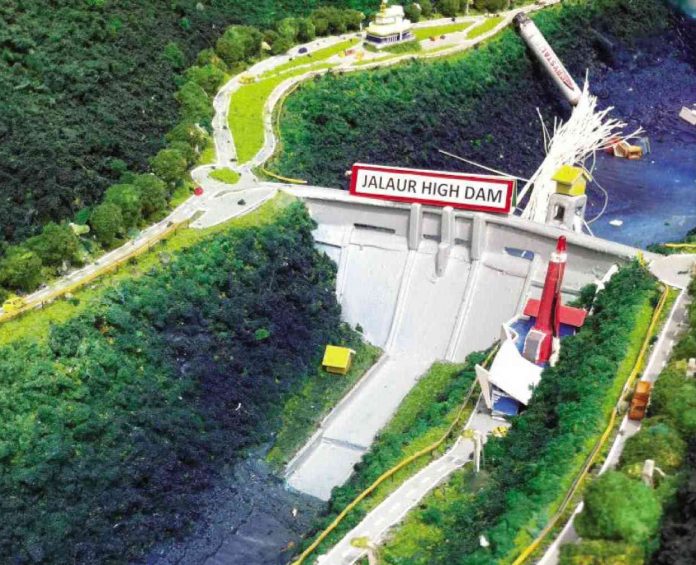
ILOILO – There’s no stopping the P11.2-billion Jalaur River Multipurpose Project Phase II (JRMP II) in the municipality of Calinog. The signing of the construction contract is on Sept. 3 at the National Irrigation Administration (NIA) Complex in Quezon City.
The dam is seen to improve agricultural production in Iloilo.
The contract signing is between NIA, the project’s implementing agency, and Daewoo Engineering & Construction Co., Ltd., the contractor, said Gov. Arthur Defensor Sr. yesterday.
In April this year, leaders of three groups opposed to the mega dam went to South Korea to protest the project that is mainly funded by the Korean government through a loan. They claimed the dam would displace and violate the rights of Calinog’s indigenous people.
Once completed, this large-scale reservoir dam – said to be the biggest outside Luzon – will provide uninterrupted irrigation water supply to 32,000 hectares of Iloilo farmland, benefit more than 783,000 farmers and increase annual production of rice to 300,000 metric tons from 140,000.
The project will also generate approximately 17,000 local jobs equivalent to P1.3 billion in basic wages per year, according to Sen. Franklin Drilon who initiated the project in April 2011 when he met with the Korean government for the funding requirement.
Calinog’s Mayor Alex Centena said his municipality alone could not possibly generate the 17,000 manpower so he appealed to other Iloilo towns to supply workers, too, such as masons, welders, drivers, and electricians, among others.
“Kon sin-o interesadso nga kabanwahanan nga mag-apply welcome gid sila tanan,” said Centena.
Calinog’s Sangguniang Bayan in May this year declared as persona non grata the three persons who went to South Korea to protest the mega dam project.
“They want to hamper the development of our locality,” read part of the SB resolution.
The three persons were Remia Castor of Barangay Alibunan, Calinog and council member of the Tumandok Indigenous Peoples in the municipality; John Ian Alenciaga, coordinator of the Jalaur River for the People’s Movement; and Cynthia Deduro, executive director of Dagsaw Panay and Guimaras Indigenous People’s Network.
JRMP II includes the construction of 109-meter Jalaur high dam; a 38.5-meter afterbay dam; a 10-meter Alibunan catch dam; a 80.74-kilometer high line canal; generation of new areas for irrigation; and rehabilitation of existing irrigation system.
Centena said his municipal government on Wednesday started scouting for areas where the contractor could safety position its heavy equipment.
The local government is also looking for a spot for the project groundbreaking which may be held this September or October, he added.
President Rodridgo Duterte may lead the groundbreaking, said Centena.
According to SB member Renato Casinao who sponsored Resolution No. 2018-044 declaring Castor, Alenciaga and Deduro persona non grata, the indigenous people of Calinog gave their consent to the mega dam project.
Meanwhile, Drilon said the contract signing signals the start of the project which will bring back rice productivity in Western Visayas, spur the local economy and the eco-tourism industry, and increase employment opportunities, particularly in Iloilo.
Agriculture in the region suffered a decline for the past years, said Drilon, citing the contribution of agriculture (in real terms) to the gross regional domestic output of Western Visayas on a downward trend from 14.1 percent in 2010 to a negative 3.3 percent in 2013 brought about by a sharp decrease in sugarcane and palay production.
The volume of production for palay has been declining in Western Visayas – from 2,292,201 metric tons (mt) in 2012, 2,090,790 mt in 2013, and 2,052,574 mt in 2014, he noted.
“At 24.4 percent agriculture is the second biggest contributor to the domestic output of Western Visayas, next to services at 57.2 percent. Hence, a decline in employment in the sector has a bearing on the poverty incidence in the region and on the economy,” said Drilon.
The decline in agricultural output affected agricultural employment in the region, from 5.63 percent in 2011 to negative 2.89 percent in 2013.
JRMP II was first implemented by NIA in the 1960s after the fourth Congress passed Republic Act 2651, which provided for the construction of the JRMP in Iloilo.
Its first phase was completed in 1980s but its second phase was derailed for over five decades due to lack of funds.
In July 2016 the Jalaur River for the People’s Movement, an alliance composed of environmental advocates, peoples’ organizations, church people, members of the academe and indigenous people’s organizations, launched an international solidarity mission against the mega dam project.
It claimed the project will directly affect 16 IP communities, nine of which will be totally submerged in water.
It also warned of adverse ecological impacts.
The main infrastructure, according to the group, would be located 11 kilometers from the active Western Panay Fault which caused a strong earthquake in Panay Island in 1948.
It was the Korean government through its Export-Import Bank’s Economic Development Cooperation Fund which extended P8.95-billion as official development assistance to implement the project. The government counterpart fund is P2.2 billion.
Drilon said the interest rate for the JRMP II loan is the lowest the country can get at 0.15 percent compared to the loans being offered by China, which is three percent interest rate.
Drilon and Defensor are attending the contract signing. Also expected there are officials of the NIA led by Administrator Ricardo Visaya and Region 6 manager Gerardo Corsiga; and officials of the Korea Export-Import Bank and Daewoo.
Drilon is confident that the project will not suffer from any more delays given NIA and Daewoo’s commitment to fast track the implementation.
“I share the optimism of NIA that we can already proceed at the soonest with the groundbreaking and actual construction,” Drilon said./PN





